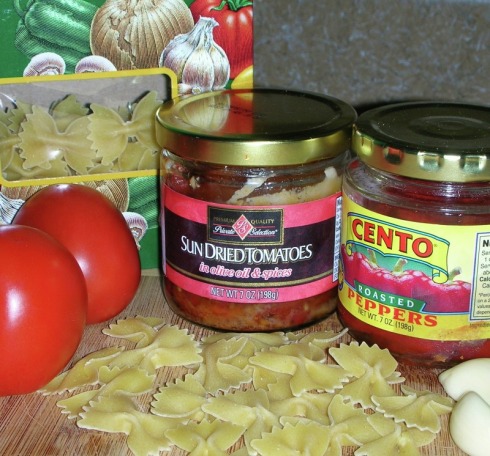Pasta 101
(Cooking, Storing, Quick tips)
Preparing the Perfect Pasta
How do you cook pasta perfectly every time?
How to Store Pasta
Quick Tips
The National Pasta Association offers these tips and meal solutions to make healthy and quick cooking a reality.
How do you cook pasta perfectly every time?
- Boil 4 to 6 quarts of water for one pound (1pound=0.45kg=2cups) of dry pasta. (1quart=0.94 liters=4cups) with a tsp of salt and olive oil to prevent sticking.
- Add the pasta with a stir and return the water to a boil.
- Stir the pasta occasionally during cooking.
- Follow the package directions for cooking times. If the pasta is to be used as part of a dish that requires further cooking, undercook the pasta by 1/3 of the cooking time specified on the package.
- Taste the pasta to determine if it is done. Perfectly cooked pasta should be "al dente," or firm to the bite, yet cooked through.
- Drain pasta immediately and follow the rest of the recipe
How to Store Pasta
- Uncooked Pasta Uncooked/dry pasta can be stored in your cupboard for up to a year. Keep in a cool, dry place. Follow the "first-in, first-out" rule: Use up packages you've had the longest before opening new packages.
- Cooked Pasta Refrigerate cooked pasta in an airtight container for 3 to 5 days. You may add a little oil (1-2 tsp. for each pound of cooked pasta) to help keep it from sticking. Because cooked pasta will continue to absorb flavors and oils from sauces, store cooked pasta separately from sauce.
- Freezing Pasta The best pasta shapes for freezing are those that are used in baked recipes, such as: lasagne, jumbo shells, ziti and manicotti. You'll have better results if you prepare the recipe and freeze it before baking. To bake, thaw the dish to room temperature and bake as the recipe directs
Quick Tips
The National Pasta Association offers these tips and meal solutions to make healthy and quick cooking a reality.
- When creating an impromptu pasta dish, remember that "less is more" and limit the number of ingredients that you use. Oil, garlic, crushed tomatoes, fresh basil and hot pepper flakes is one delicious combination.
- Be creative! Toss pasta with a little vegetable oil, tomato or broth for a simple sauce.
- Try a no-cook sauce by marinating tomatoes, chopped fresh mozzarella and fresh basil leaves in a little oil. Toss with hot pasta for a quick, delicious meal.
- For a change of taste, try pureed roasted red peppers as a sauce.
- Keep fresh herbs on hand as a quick and easy way to add a lot of flavor. Basil, which has a very fresh, delicate flavor, is best added to sauces at the last minute to maximize its flavor. Rosemary is woodsy, so it's especially suited to cream sauces and earthy ingredients, like mushrooms.
- When creating a sauce, start with a broth or a vegetable puree as a base instead of cream and butter. One way to slim down your favorite lasagne recipe, for instance, is to cut the quantity of ricotta cheese in half and puree it with two large eggplants that have been roasted and peeled.
- Use a blender or a juicer to create your own combinations of vegetable purees. Then just bring to a simmer with your favorite herbs and spices and toss with pasta.
- Pairing pasta with legumes, such as beans and lentils, or low-fat dairy products makes for protein-rich, but inexpensive and delicious meatless meals.
- Add vegetables to a light tomato sauce for a plenty of flavor and crunch.
- Add leftover pasta to your favorite soup. If you use dry pasta, simmer the soup for an additional 5 to 10 minutes or until the pasta is cooked.
- Experiment with spices and fresh herbs to add interest and flavor. For instance, try cilantro instead of basil in your favorite pesto recipe, or spicy chilies like Serrano or Poblanos in a traditional pasta dish.
- Top pasta with leftovers for a quick and inexpensive meal. Cook and drain a fresh pot of pasta and add last night’s cooked vegetables.
- Think texture as well as flavor. Add a toss of toasted pine nuts or toasted chopped walnuts to a creamy pasta sauce for added interest.
- Don't be afraid to substitute ingredients. If you plan to use zucchini in a pasta sauce, but the eggplant looks particularly good, substitute the eggplant.
- Double your favorite recipes, and freeze the extra servings for later use. This works especially well with sauces and baked pasta dishes like lasagne.
- Make mealtime more enjoyable by serving different, fun shapes - stars, letters, wheels and the all-time kid favorite ... spaghetti. Introduce young pasta eaters to finger-friendly sizes like ziti, rotini (spirals), and radiatore (radiators).
- Keep leftover cooked pasta in the refrigerator for up to three days. When it's time to reheat, simply put it in a colander and then place it directly into boiling water for one minute.
- Use only small amounts of vegetable oils, margarine and vegetable cooking spray when preparing pasta dishes.

